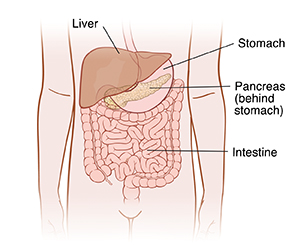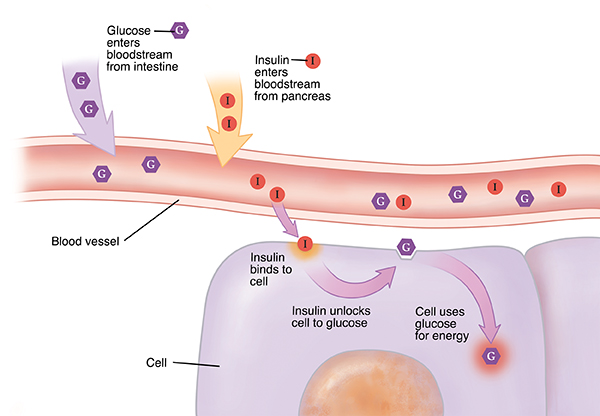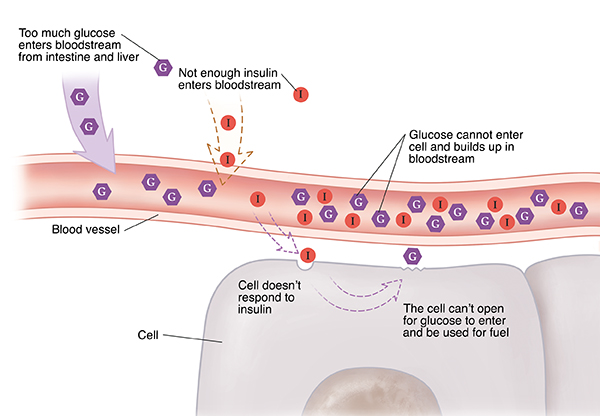Diabetes and Your Child: Understanding Type 2 Diabetes
Your child has type 2 diabetes. This means their body has trouble using a sugar called glucose for energy. Diabetes is a lifelong condition. If not treated, it can lead to serious health problems. Diabetes can be managed so your child can live a full, healthy life. Type 2 diabetes has not been common in children, But, in recent years, more children are developing type 2 diabetes. This may be linked to a rise in childhood obesity.
How the body gets energy
When your child eats, their digestive system breaks down food. Some of this food is turned into glucose in the intestines. Glucose is also stored in and released by the liver. Glucose gives energy to the body’s cells. It travels through the blood to reach the cells. Glucose needs the help of a hormone called insulin to leave the blood and enter cells. Insulin is made by an organ called the pancreas. Insulin is released into the blood, and travels to the cells just like glucose. When insulin reaches a cell, it acts like a key. It opens a “door” into the cell so glucose can enter.


When your child has type 2 diabetes
With type 2 diabetes, food is still broken down into glucose. Glucose still travels to the cells. But the pancreas may not make enough insulin for the amount of glucose in the blood. The liver may release too much glucose at once. And the body’s cells may not respond the right way to insulin. This is called insulin resistance. Because of this, the cells get less glucose than they need. At first, the pancreas makes more insulin to try to keep up. As time passes, the pancreas can’t make enough insulin to overcome resistance. When this happens, glucose builds up in the bloodstream. Too much glucose in the blood is called hyperglycemia (high blood sugar). Without glucose getting into cells, your child’s cells don’t get the energy they need. Over time, high blood sugar can cause other more serious health problems.

What causes type 2 diabetes?
Type 2 diabetes often runs in families. African American, Latino, Native American, Asian American, and Pacific Islander families are often affected. Your child may be more likely to develop diabetes if:
-
They are female
-
They spend more time sitting than being active
-
They are overweight for age and height
-
A parent or sibling has diabetes
-
The mother had diabetes during pregnancy (gestational diabetes)
-
They had a low birth weight
What are the symptoms of type 2 diabetes?
When your child has type 2 diabetes, the body’s cells become starved for energy. Most often, a child may not have any symptoms. Or your child may have some of the following symptoms:
-
Very thirsty
-
Increased urination
-
Blurry vision
-
Tiredness during the day
-
Extreme hunger
-
Bed-wetting or getting up at night to urinate
-
Weight gain or unexplained weight loss
-
Trouble concentrating
-
Vaginal infections caused by fungi
Even if your child has no symptoms, high blood sugar can still be causing harm.
How is type 2 diabetes diagnosed?
Blood tests can help show if your child has type 2 diabetes. Your child may have tests, such as:
-
Hemoglobin A1C test. This test measures the average blood glucose for the past 2 to 3 months. An A1C of 6.5% or higher means your child has diabetes.
-
Fasting plasma glucose (FPG). This test checks blood glucose levels after 8 hours of fasting. Your child will have this test before their first meal of the day. This is called the fasting blood glucose level. A result higher than or equal to 126 mg/dl means your child has diabetes.
-
Oral glucose tolerance test (OGTT). For this test, your child's glucose level is measured before and then after 2 hours after having a sugary drink. This shows how well their body uses glucose. A result of 200 mg/dL or higher after 2 hours means your child has diabetes.
-
Random glucose test. This blood test is done at any time of the day. Blood glucose of 200 mg/dL or higher with symptoms of high blood sugar means your child has diabetes.
If your child doesn't have any symptoms of high blood sugar, they will need to have 2 abnormal test results from the same sample or in 2 separate test samples to be diagnosed. For example: Your child would need a fasting plasma glucose greater than 126 and an A1C greater than 6.5% from the same sample.
How is type 2 diabetes treated?
There is no cure for type 2 diabetes. But it can be managed. Your child’s healthcare provider will work with you to create a treatment plan. Following the plan will help keep your child’s blood sugar in a healthy range. Type 2 diabetes is most often treated by:
What are the long-term concerns?
People with a blood sugar level that is too high over many years can develop health problems. These problems can affect the heart, eyes, kidneys, and nerves. You CAN help delay or prevent these problems in your child. To do this, work with your healthcare team to manage your child’s blood sugar as directed.
To learn more
For more information about diabetes, visit these websites:
-
American Diabetes Association www.diabetes.org
-
Children with Diabetes www.childrenwithdiabetes.org
-
Juvenile Diabetes Research Foundation www.jdrf.org
-
American Association of Diabetes Educators www.aadenet.org
-
American Association of Clinical Endocrinologists www.aace.com
-
National Diabetes Information Clearinghouse www.diabetes.niddk.nih.gov
How daily issues affect your health
Many things in your daily life impact your health. This can include transportation, money problems, housing, access to food, and childcare. If you can’t get to medical appointments, you may not get the care you need. When money is tight, it may be hard to pay for medicines. And living far from a grocery store can make it hard to buy healthy food.
If you have any concerns, talk with your healthcare team. They may know of local resources to help you. Or they may have a staff person who can help.
Follow up with your healthcare provider
This sheet doesn't give all the information you need to care for your child with diabetes. Ask your child’s healthcare provider for more information.